Algorithm and Application of Foundation Displacement Monitoring of Railway Cable Bridges Based on Satellite Observation Data
Abstract
1. Introduction
2. Theoretical Background
2.1. Extraction of Multipath Effect
2.2. Denoising Random Noise
3. Test for GNSS Monitoring System
4. Method to Extract Foundation Settlement by Satellite Monitoring
- The poor values can be eliminated according to the median absolute difference of three times, and the data loss induced by signal masking can be compensated by linear interpolation, to obtain the pre-processed signal.
- The GNSS signal denoised by SWT and EMD.
- The hyperbolic model is applied to fitting the parameters of GNSS signal and the settlement data obtained by precise leveling, respectively.
- In order to correct the foundation settlement of bridge tower, two three-layer backpropagation neural network structures were used for mapping from the a׳ and b׳ fitting by GNSS signal to the a and b fitting by the precise leveling.
5. Cased Study
5.1. Monitoring System of Foundation Displacement of Long-Span Bridge
5.2. Data Preprocessing
5.3. Wavelet Basis Function
5.4. Random Noise Reduction by EMD Decomposition
5.5. GNSS Signal Correction
6. Conclusions
- It can achieve desirable effect for using the stationary wavelet denoising to eliminate the multipath error in GNSS signals;
- Autocorrelation function-based EMD denoising algorithm can effectively process GNSS signals with random noise;
- Based on measured data in construction process, the nonlinear mapping between the precise leveling data and GNSS signals can be established by the BP neural network;
- The position and reliability of GNSS measurements can be improved by using the proposed method in this study. The GNSS signal processing method presented in this paper makes the submillimeter monitoring of foundation settlement of long-span bridges come true.
Author Contributions
Funding
Institutional Review Board Statement
Informed Consent Statement
Data Availability Statement
Conflicts of Interest
References
- Brownjohn, J.M.W.; Koo, K.-Y.; Scullion, A.; List, D. Operational deformations in long-span bridges. Struct. Infrastruct. Eng. 2015, 11, 556–574. [Google Scholar] [CrossRef]
- Quesada-Olmo, N.; Jimenez-Martinez, M.J.; Farjas-Abadia, M. Real-time high-rise building monitoring system using global navigation satellite system technology. Measurement 2018, 123, 115–124. [Google Scholar] [CrossRef]
- Xi, R.; Jiang, W.; Meng, X.; Chen, H.; Chen, Q. Bridge monitoring using BDS-RTK and GPS-RTK techniques. Measurement 2018, 120, 128–139. [Google Scholar] [CrossRef]
- Yi, T.; Li, H.; Gu, M. Recent research and applications of GPS based technology for bridge health monitoring. Sci. China Technol. Sci. 2010, 53, 2597–2610. [Google Scholar] [CrossRef]
- Chen, D.; Ye, S.; Zhou, W.; Liu, Y.; Jiang, P.; Tang, W.; Yuan, B.; Zhao, L. A double-differenced cycle slip detection and repair method for GNSS CORS network. GPS Solut. 2016, 20, 439–450. [Google Scholar] [CrossRef]
- Mosavi, M.R. Comparing DGPS corrections prediction using neural network, fuzzy neural network, and Kalman filter. GPS Solut. 2006, 10, 97–107. [Google Scholar] [CrossRef]
- Azarbad, M.R.; Mosavi, M.R. A new method to mitigate multipath error in single-frequency GPS receiver with wavelet transform. GPS Solut. 2014, 18, 189–198. [Google Scholar] [CrossRef]
- Chan, W.S.; Xu, Y.L.; Ding, X.L.; Dai, W.J. An integrated GPS–accelerometer data processing technique for structural deformation monitoring. J. Geod. 2006, 80, 705–719. [Google Scholar] [CrossRef]
- Xu, Y.; Brownjohn, J.M.W.; Hester, D.; Koo, K.Y. Long-span bridges: Enhanced data fusion of GPS displacement and deck accelerations. Eng. Structures. 2017, 147, 639–651. [Google Scholar] [CrossRef]
- Stiros, S.C. Errors in velocities and displacements deduced from accelerographs: An approach based on the theory of error propagation. Soil Dyn. Earthq. Eng. 2008, 28, 415–420. [Google Scholar] [CrossRef]
- Erickson, J.W.; Maybeck, P.S.; Raquet, J.F. Multipath-adaptive GPS/INS receiver. IEEE Trans. Aerosp. Electron. Syst. 2005, 41, 645–657. [Google Scholar] [CrossRef]
- Kaplan, E.D.; Hegarty, C. Understanding GPS: Principles and Applications; Artech House: Norwood, MA, USA, 2005. [Google Scholar]
- Pugliano, G.; Robustelli, U.; Rossi, F.; Santamaria, R. A new method for specular and diffuse pseudorange multipath error extraction using wavelet analysis. GPS Solut. 2016, 20, 499–508. [Google Scholar] [CrossRef]
- Huang, N.E.; Shen, Z.; Long, S.R.; Wu, M.C.; Shih, H.H.; Zheng, Q.; Yen, N.-C.; Tung, C.C.; Liu, H.H. The empirical mode decomposition and the Hilbert spectrum for nonlinear and non-stationary time series analysis. Proc. R. Soc. London. Ser. A Math. Phys. Eng. Sci. 1998, 454, 903–995. [Google Scholar] [CrossRef]
- Wu, Z.; Huang, N.E. Ensemble empirical mode decomposition: A noise-assisted data analysis method. Adv. Adapt. Data Anal. 2009, 1, 1–41. [Google Scholar] [CrossRef]
- Boudraa, A.O.; Cexus, J.C. EMD-Based Signal Filtering. IEEE Trans. Instrum. Meas. 2007, 56, 2196–2202. [Google Scholar] [CrossRef]
- Peng, Z.K.; Tse, P.W.; Chu, F.L. A comparison study of improved Hilbert–Huang transform and wavelet transform: Application to fault diagnosis for rolling bearing. Mech. Syst. Signal Process. 2005, 19, 974–988. [Google Scholar] [CrossRef]
- Ayenu-Prah, A.; Attoh-Okine, N. A Criterion for Selecting Relevant Intrinsic Mode Functions in Empirical Mode Decomposition. Adv. Adapt. Data Anal. 2010, 2, 1–24. [Google Scholar] [CrossRef]
- Asaoka, A. Observational procedure of settlement prediction. Soils Found. 1978, 18, 87–101. [Google Scholar] [CrossRef] [PubMed]
- Tan, S. Hyperbolic method for settlements in clays with vertical drains. Can. Geotech. J. 1994, 31, 125–131. [Google Scholar] [CrossRef]
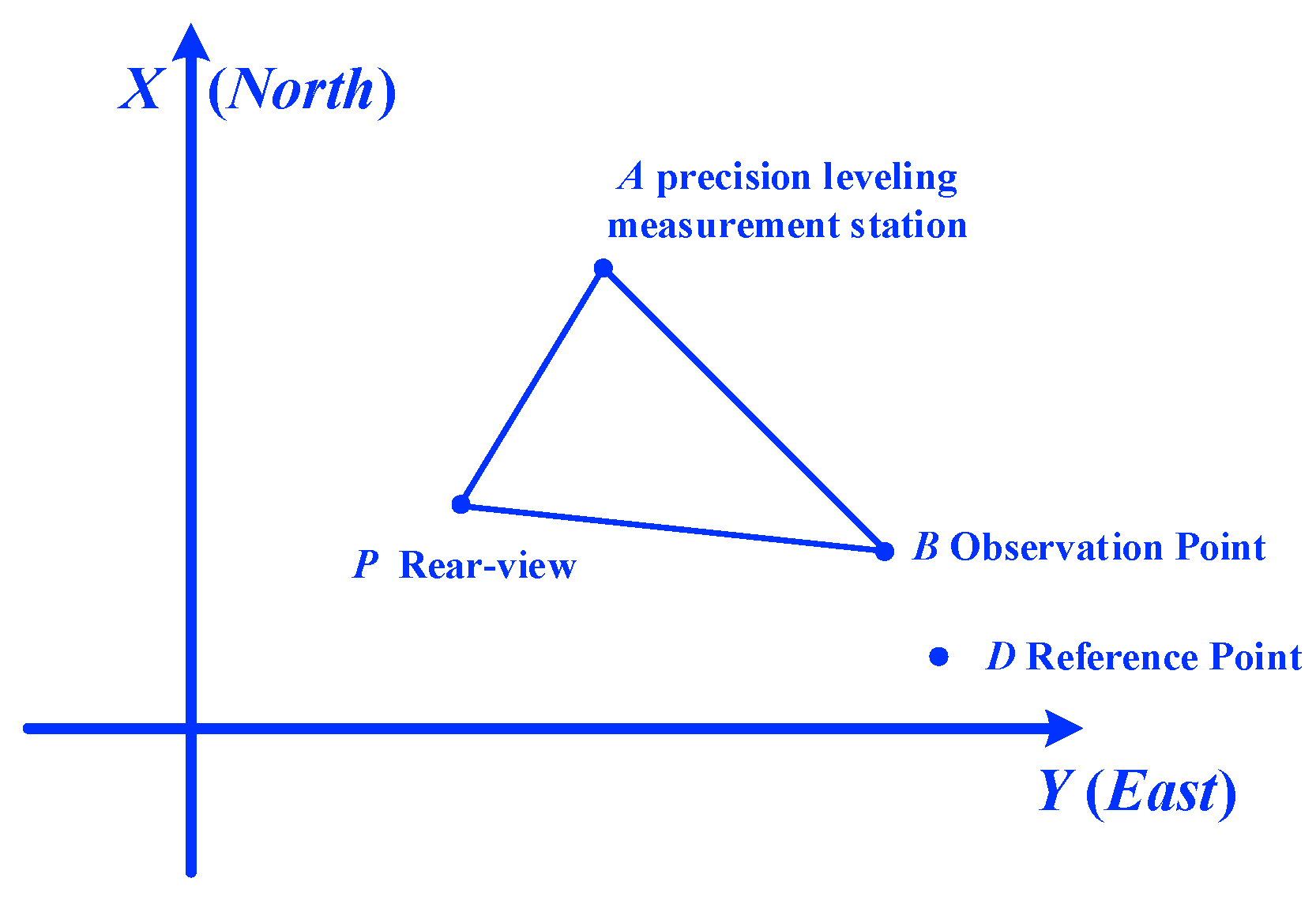
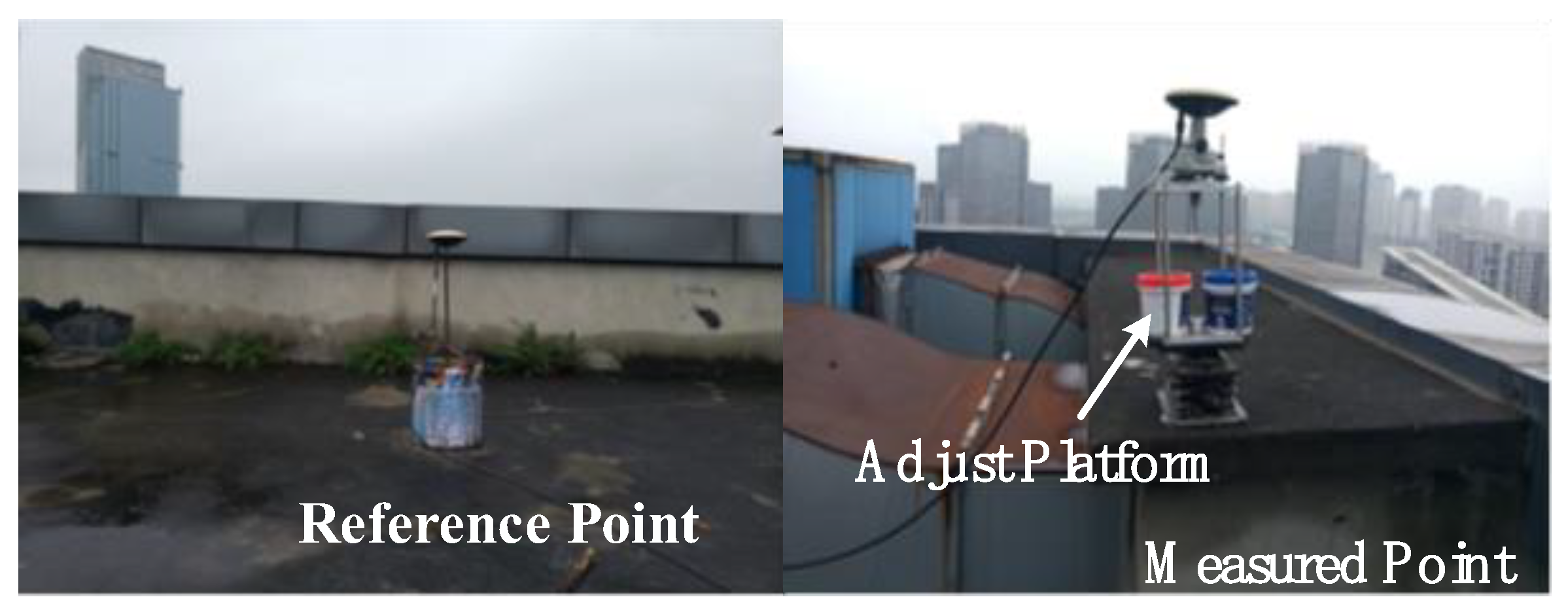



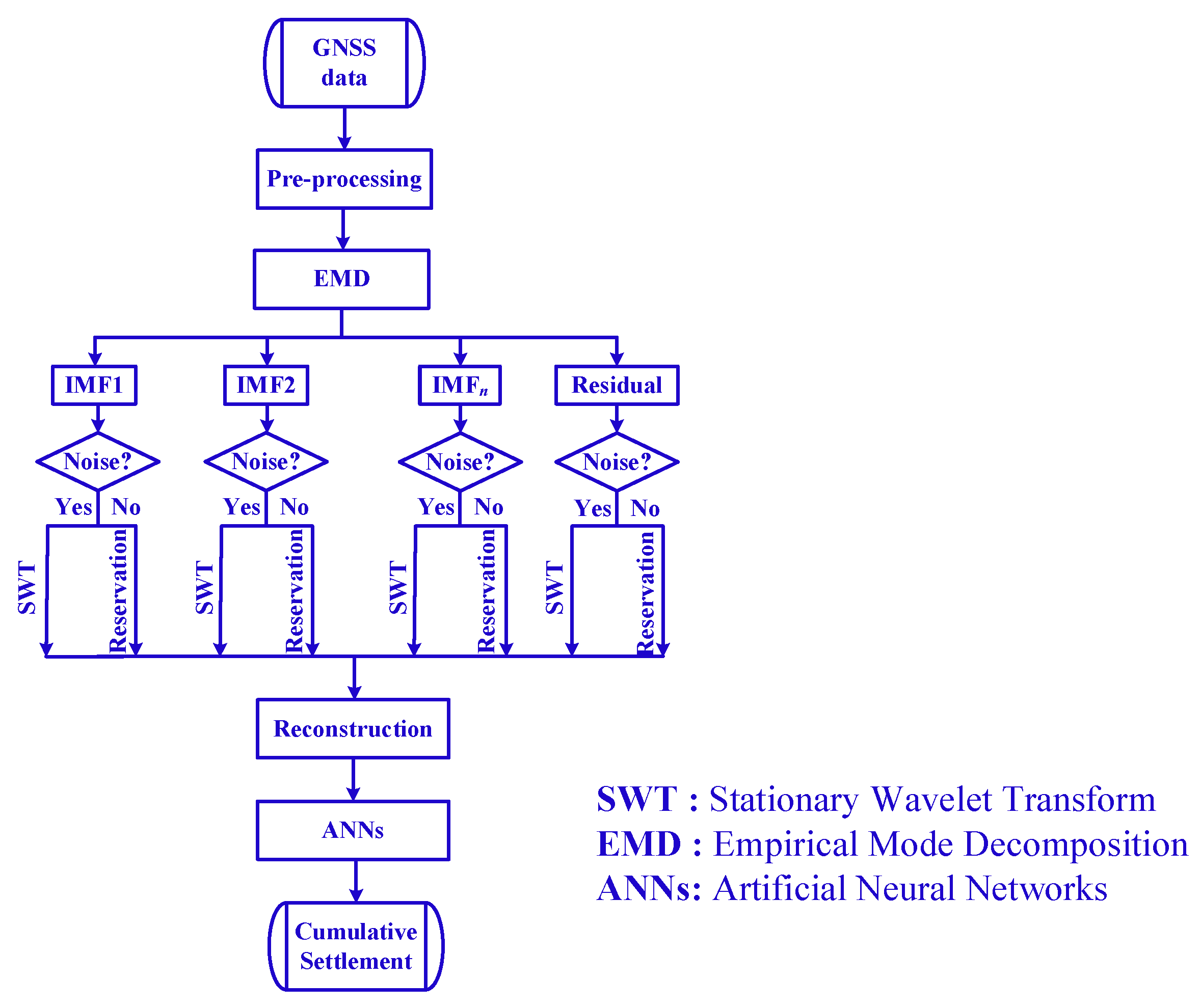

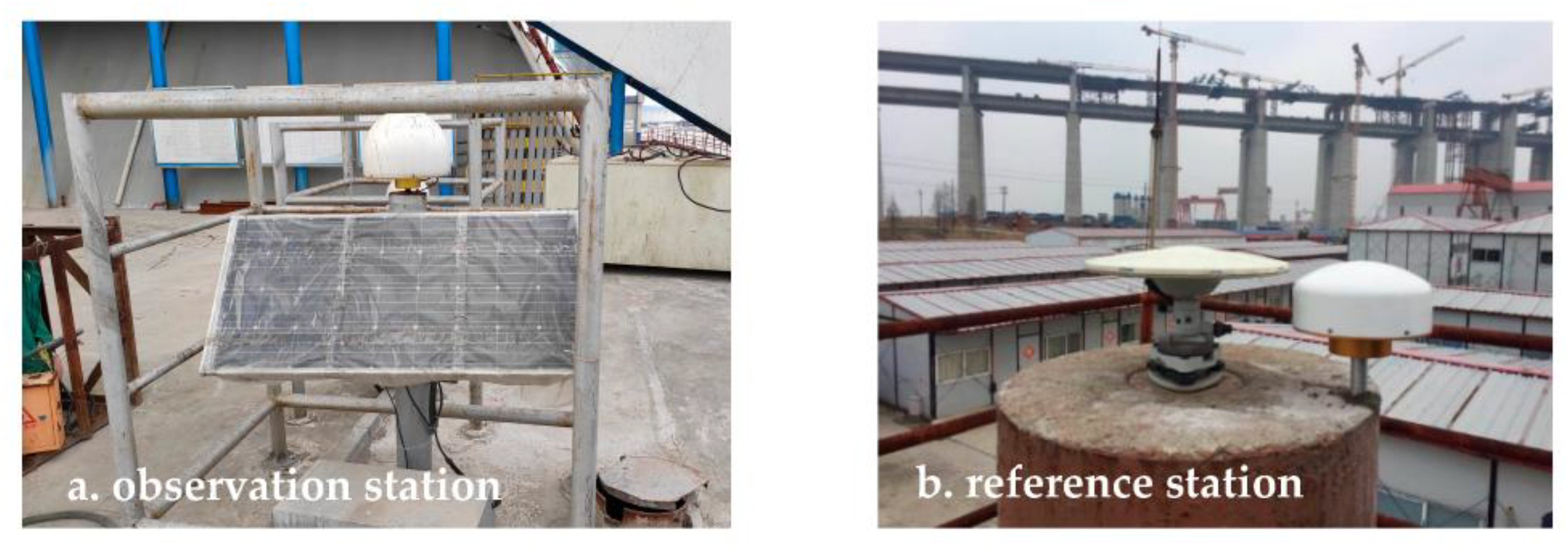
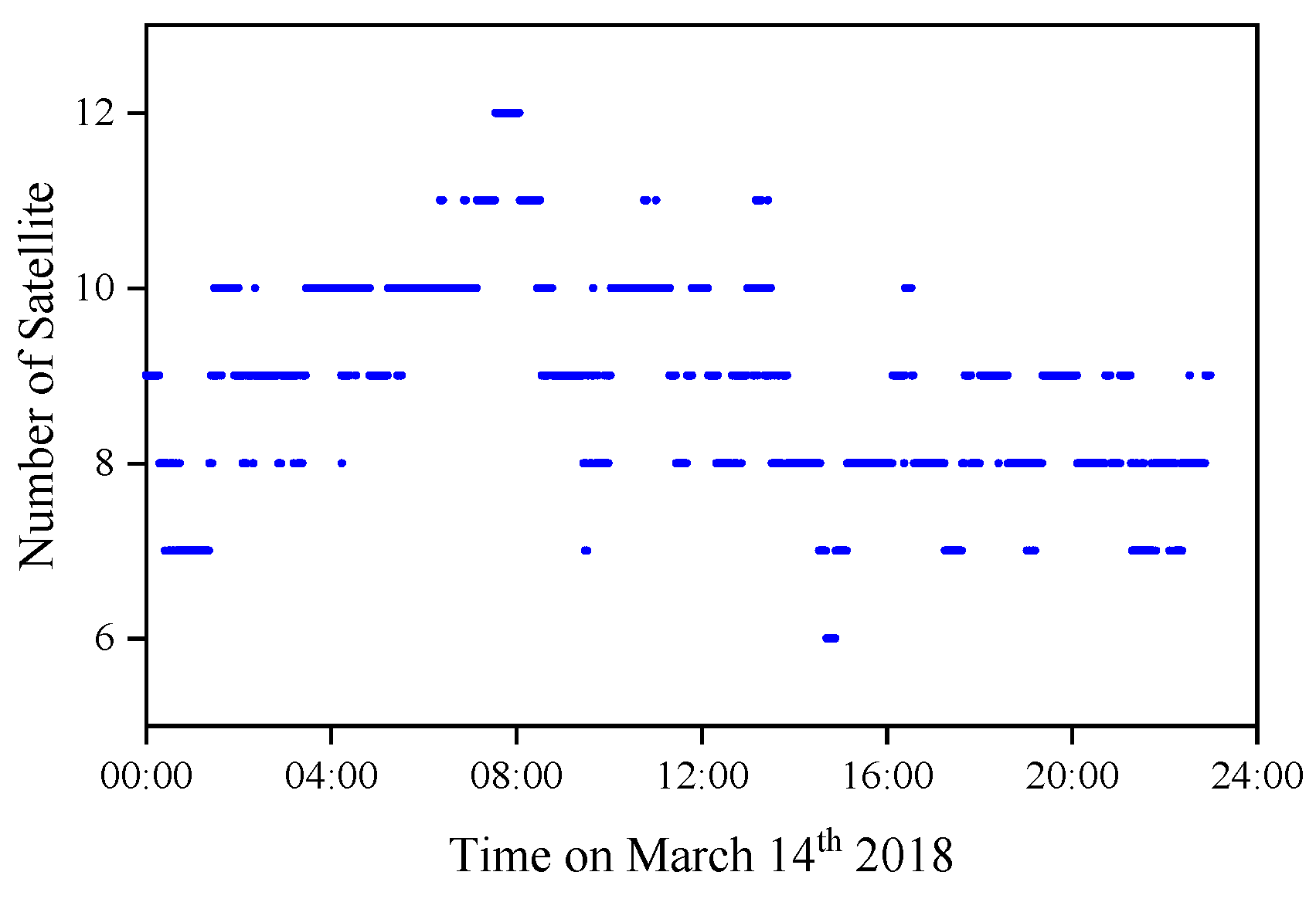

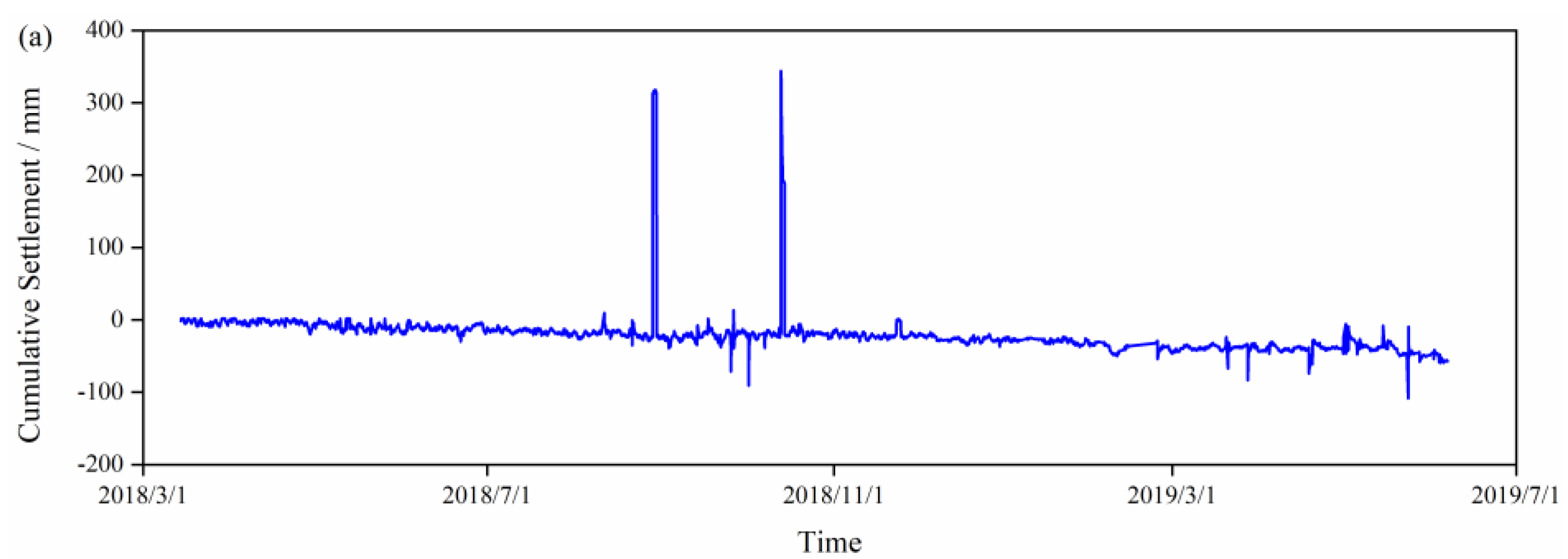
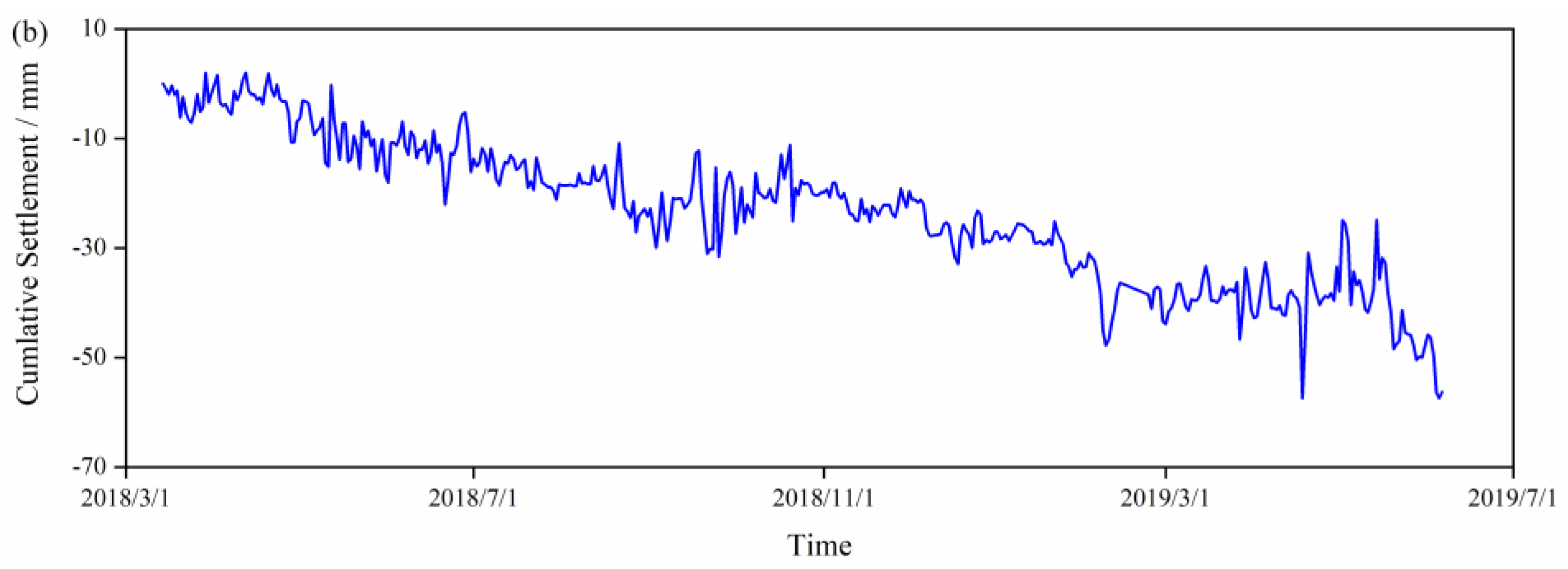

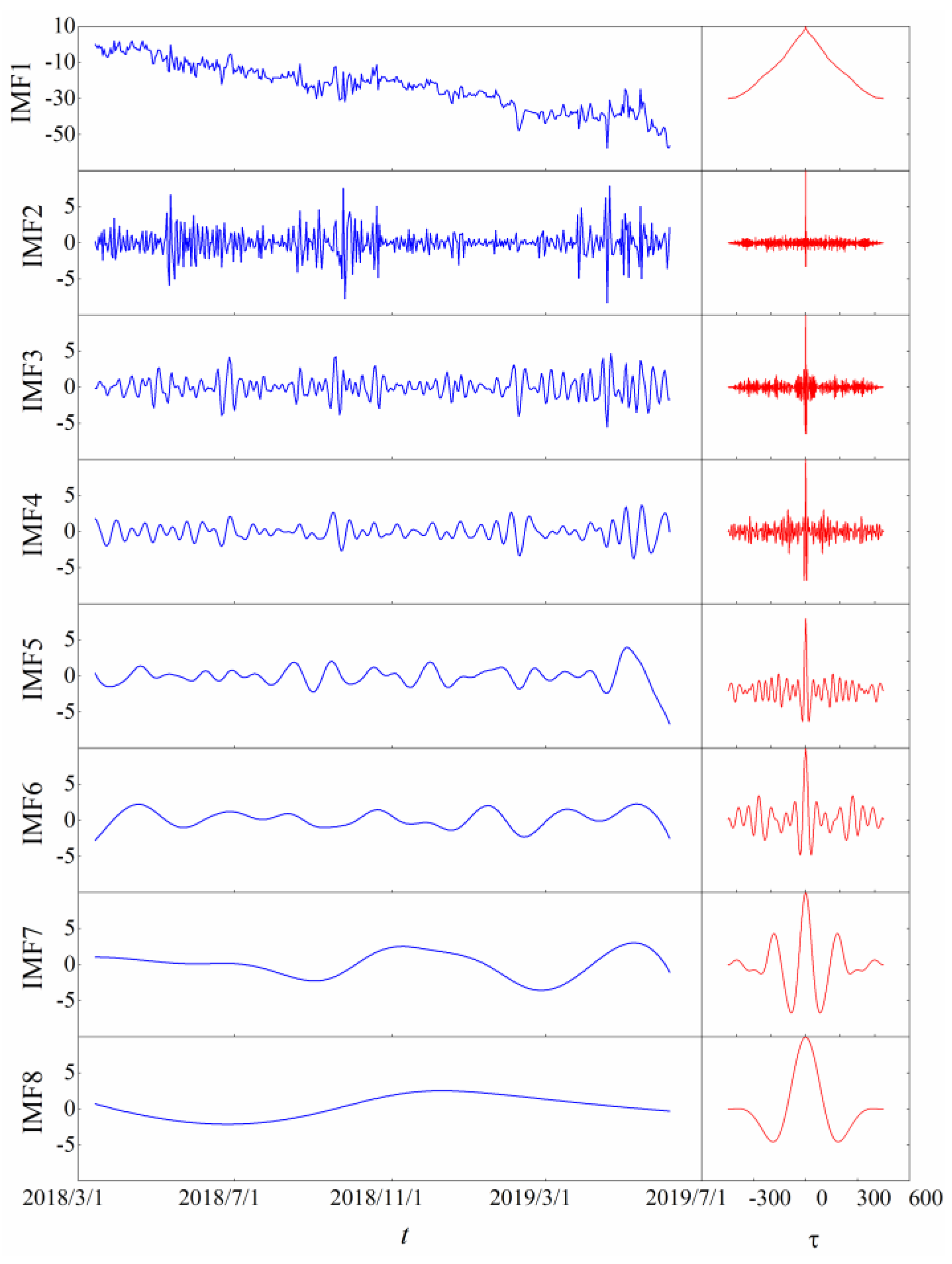
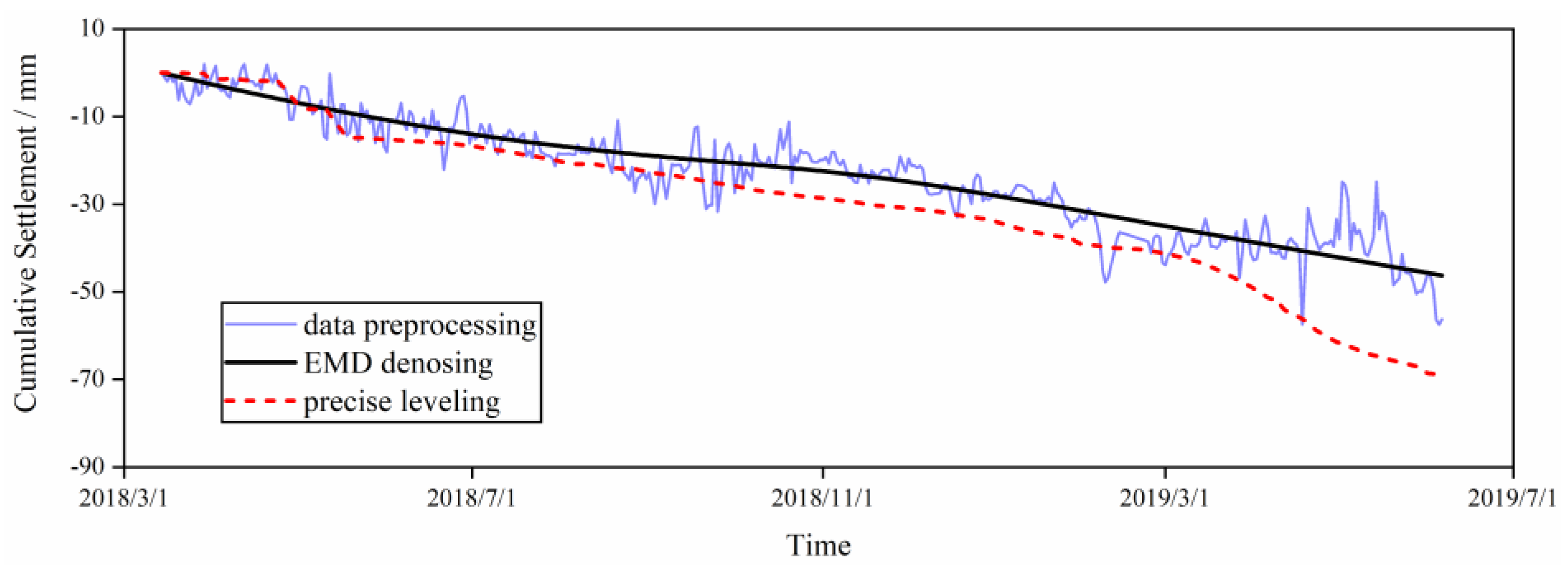
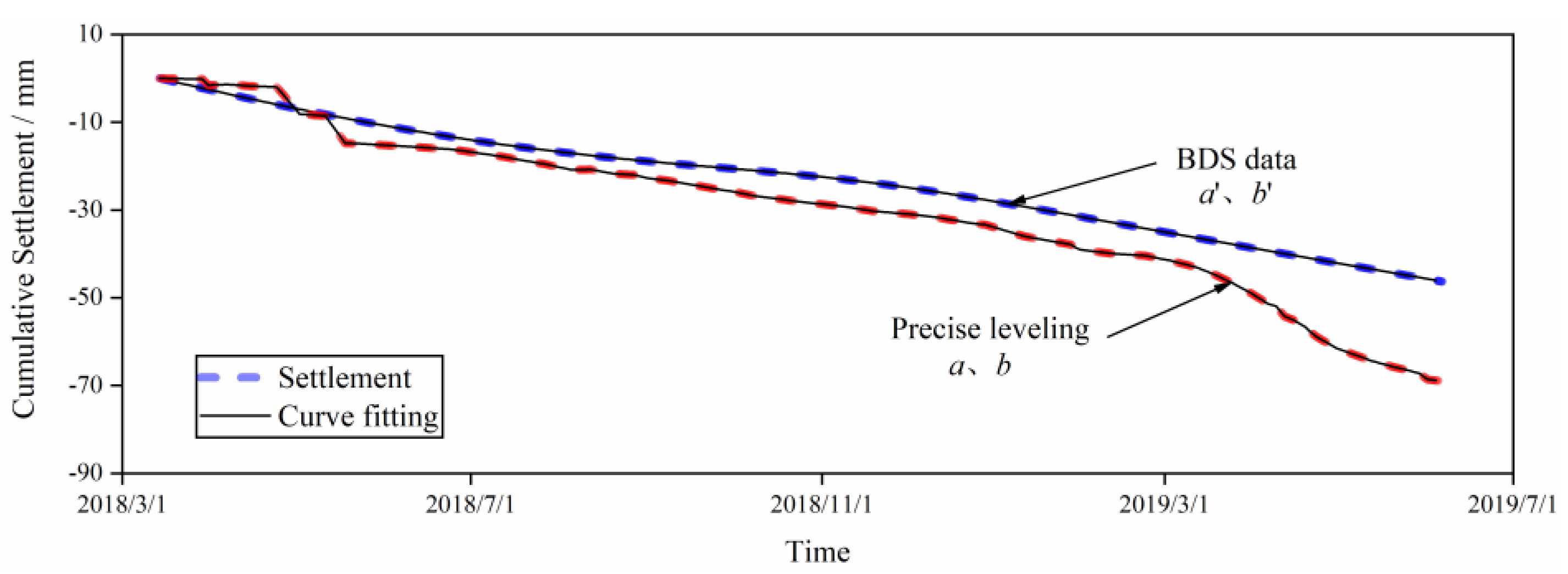
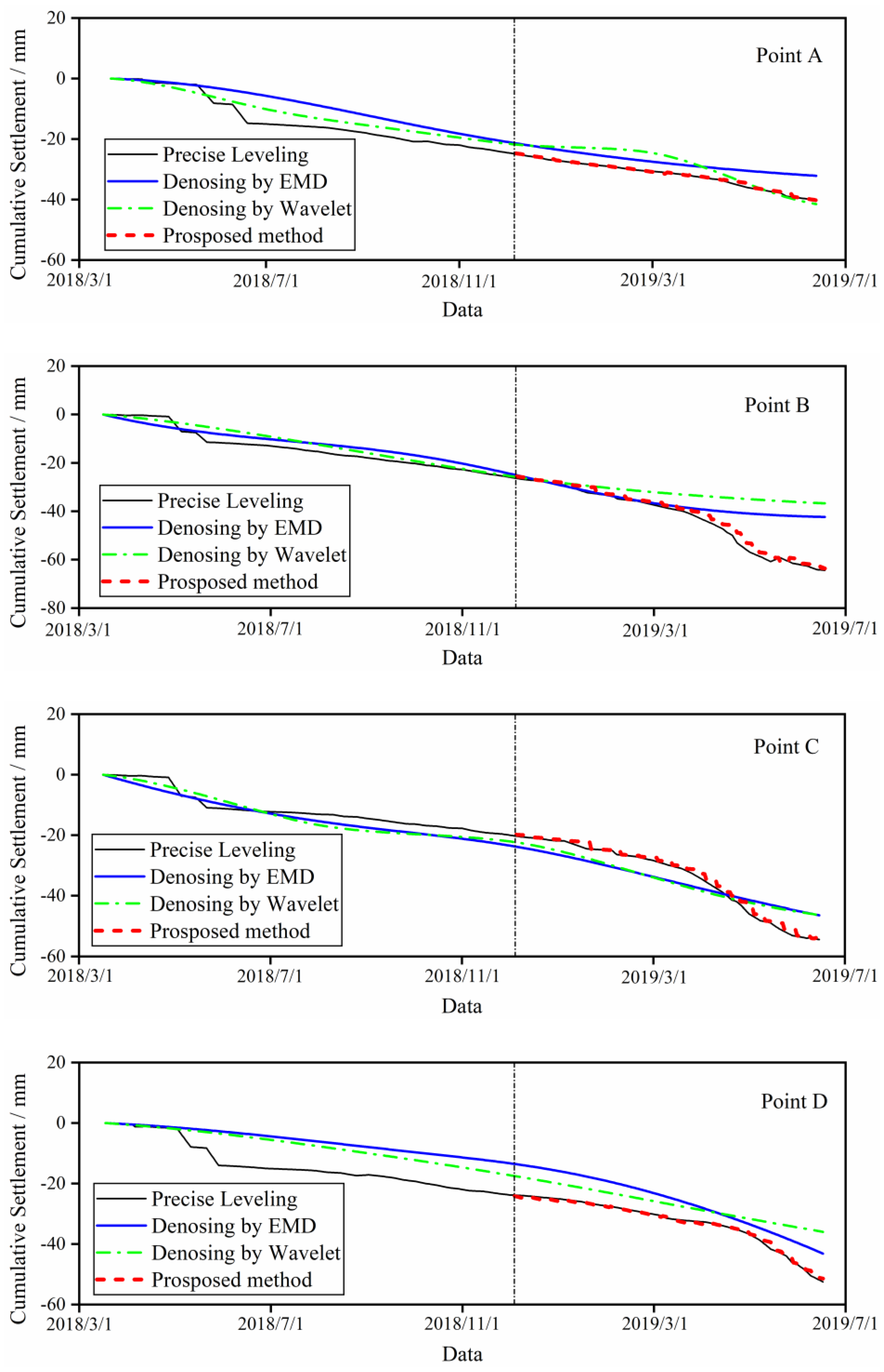
| SNR | RMSE | |
|---|---|---|
| sym1 | 13.1 | 5.4 |
| sym2 | 16.9 | 3.5 |
| sym3 | 14.7 | 4.5 |
| sym5 | 15.5 | 4.1 |
| sym8 | 14.4 | 4.5 |
| Neural Networks | Transfer Function | MAE (mm) | MAPE | RMSE (mm) |
|---|---|---|---|---|
| 4-7-1 | Tangent Sigmoid | 0.57 | 0.015 | 0.68 |
| 4-7-1 | Logarithmic Sigmoid | 0.51 | 0.015 | 0.66 |
| 4-7-1 | Line | 0.64 | 0.017 | 0.73 |
| 4-8-1 | Tangent Sigmoid | 0.67 | 0.018 | 0.77 |
| 4-8-1 | Logarithmic Sigmoid | 0.47 | 0.012 | 0.43 |
| 4-8-1 | Line | 0.64 | 0.017 | 0.74 |
| 4-9-1 | Tangent Sigmoid | 0.67 | 0.018 | 0.77 |
| 4-9-1 | Logarithmic Sigmoid | 0.50 | 0.013 | 0.61 |
| 4-9-1 | Line | 0.60 | 0.016 | 0.70 |
| SNR (dB) | RMSE (mm) | |||||
|---|---|---|---|---|---|---|
| EMD | DWT | Proposed Method | EMD | DWT | Proposed Method | |
| Point A | 9.8 | 17.7 | 37.5 | 4.9 | 4.2 | 0.4 |
| Point B | 13.0 | 10.3 | 27.8 | 9.1 | 12.4 | 0.7 |
| Point C | 16.7 | 17.4 | 36.8 | 4.7 | 4.3 | 0.4 |
| Point D | 11.9 | 13.2 | 35.8 | 8.0 | 6.9 | 0.5 |
Disclaimer/Publisher’s Note: The statements, opinions and data contained in all publications are solely those of the individual author(s) and contributor(s) and not of MDPI and/or the editor(s). MDPI and/or the editor(s) disclaim responsibility for any injury to people or property resulting from any ideas, methods, instructions or products referred to in the content. |
© 2023 by the authors. Licensee MDPI, Basel, Switzerland. This article is an open access article distributed under the terms and conditions of the Creative Commons Attribution (CC BY) license (https://creativecommons.org/licenses/by/4.0/).
Share and Cite
Zhu, Y.; Shuang, M.; Sun, D.; Guo, H. Algorithm and Application of Foundation Displacement Monitoring of Railway Cable Bridges Based on Satellite Observation Data. Appl. Sci. 2023, 13, 2868. https://doi.org/10.3390/app13052868
Zhu Y, Shuang M, Sun D, Guo H. Algorithm and Application of Foundation Displacement Monitoring of Railway Cable Bridges Based on Satellite Observation Data. Applied Sciences. 2023; 13(5):2868. https://doi.org/10.3390/app13052868
Chicago/Turabian StyleZhu, Ying, Miao Shuang, Daqi Sun, and Hui Guo. 2023. "Algorithm and Application of Foundation Displacement Monitoring of Railway Cable Bridges Based on Satellite Observation Data" Applied Sciences 13, no. 5: 2868. https://doi.org/10.3390/app13052868
APA StyleZhu, Y., Shuang, M., Sun, D., & Guo, H. (2023). Algorithm and Application of Foundation Displacement Monitoring of Railway Cable Bridges Based on Satellite Observation Data. Applied Sciences, 13(5), 2868. https://doi.org/10.3390/app13052868





